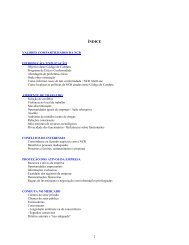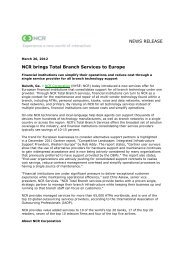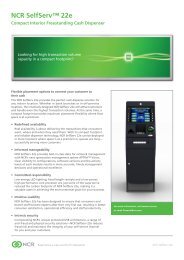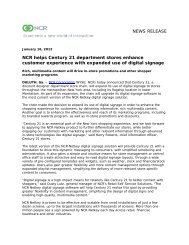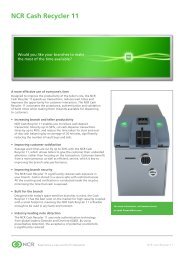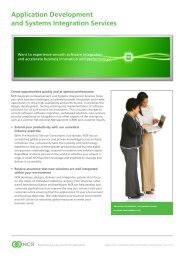Financial Inclusion White Paper - NCR
Financial Inclusion White Paper - NCR
Financial Inclusion White Paper - NCR
You also want an ePaper? Increase the reach of your titles
YUMPU automatically turns print PDFs into web optimized ePapers that Google loves.
1. Introduction to <strong>Financial</strong> <strong>Inclusion</strong><br />
About 2.9 billion 1 people around the world do not have access to formal sources of<br />
banking and financial services.<br />
In India alone 560 million 2 people are excluded from formal source of finance, a<br />
figure in tight correlation with the 41.6 percent (457 million) of the populace that<br />
still lives below the poverty line (US$1.25/day).<br />
While India has enjoyed growing domestic demand and globally recognized<br />
prowess in the areas of information technology, automotive, life sciences,<br />
telecommunications and even space exploration, its continued success and growth<br />
as an economic power (in common with other emerging economies) can only be<br />
assured if concrete steps are taken to ensure that the social and economic<br />
development is inclusive.<br />
a. The role of Government<br />
The importance of financial inclusion to<br />
national economies is evidenced by the<br />
support of individual governments as well<br />
as international bodies around the world.<br />
The United Nations Capital Development<br />
Fund (UNCDF), which is present in 33 of<br />
the identified 50 Least Developed<br />
Countries 3<br />
(LDC), invests in local<br />
development and inclusive finance with a<br />
total program portfolio amounting to<br />
US$130 million. UNCDF’s vision of<br />
inclusive finance is to offer appropriate<br />
financial services to all segments of the<br />
population to be supported by sound<br />
government policies, legal and regulatory<br />
frameworks and infrastructure. UNCDF<br />
has been instrumental in taking innovative<br />
approaches to build inclusive financial<br />
sectors to help them reduce poverty and<br />
achieve inclusive growth.<br />
“<strong>Financial</strong> <strong>Inclusion</strong> is Critical<br />
to achieve inclusive growth;<br />
which itself is a sin qua non for<br />
sustainable economic growth<br />
and development. Harnessing<br />
the power of technology is one<br />
of the most effective ways of<br />
integrating the unbanked<br />
population into the financial<br />
mainstream. Technology<br />
enables the provision of a host<br />
of services from depositing<br />
money into various government<br />
schemes to micro loans and<br />
micro insurance<br />
P Chidambaram, Home Minister,<br />
(Former Finance minister),<br />
Government of India - In a<br />
message to Frost & Sullivan for<br />
the IT enabled <strong>Financial</strong><br />
<strong>Inclusion</strong> event on 18th<br />
Sept ’08<br />
Similarly, the International <strong>Financial</strong> Corporation (IFC), a member of the World<br />
Bank, supports numerous causes designed to support the proliferation of financial<br />
inclusion.<br />
1 World Bank, United Nations<br />
2 Source: National Sample Survey Organization<br />
3 Least Developed Countries (LDC) are low income countries, where according to the United Nations;<br />
growth faces long-term impediments – such as structural weakness and low Human Resource Development.<br />
(“High Income Economies” have GNI per Capita of $11,456 or more: World bank criteria)<br />
6




